Microneedle-Assisted Percutaneous Delivery of Paeoniflorin-Loaded Ethosomes
Abstract
1. Introduction
2. Results and Discussion
2.1. Preparation of TGP-E
2.1.1. Effect of Mass Ratio of PC
2.1.2. Effect of Mass Ratio of TGP and PC
2.1.3 Effect of Water Phase pH
2.1.4. Optimization of TGP-E preparation
2.1.5. Stability Tests
2.2. Selection of Optimal MN Conditions
2.3. Ex Vivo Skin Permeation of TGP-S and MN-Assisted TGP-S
2.4. Ex Vivo Skin Permeation of TGP-E and MN-Assisted TGP-E
3. Materials and Methods
3.1. Materials
3.2. Methods
3.2.1. Preparation of TGP-E
3.2.2. High Performance Liquid Chromatography (HPLC)
3.2.3. Determination of Entrapment Efficiency
3.2.4. Single Factor Experiment
3.2.5. Formulation Optimization of TGP-E
3.2.6. Determination of Size Distribution and Zeta Potential
3.2.7. Stability Tests
3.3. Selection of MN Conditions
3.3.1. Skin Preparation
3.3.2. Skin Pretreatment with MN
3.3.3. Light Microscope
3.3.4. Data Analysis
3.3.5. Ex Vivo Skin Permeation of TGP-S and MN-Assisted TGP-S
3.3.6. Ex Vivo Skin Permeation of TGP-E and MN-Assisted TGP-E
3.4. Statistical Analysis
4. Conclusions
Author Contributions
Funding
Conflicts of Interest
Abbreviations
| TGP | Total glucosides of paeony |
| TGP-S | TGP saline solution |
| TGP-E | Paeoniflorin-loaded ethosomal solution |
| EE | Encapsulation efficiency |
| DL | Drug loading |
| PS | Particle size |
| ZP | Zeta potential |
| PDI | Polydispersity index |
| Qn | Accumulative penetration amount |
| ST | Solution transdermal |
| MST | MN-assisted TGP solution transdermal |
| PT | TGP-E transdermal |
| MPT | MN-assisted TGP-E transdermal |
References
- Zhao, J.; Zha, Q.; Jiang, M.; Cao, H.; Lu, A. Expert consensus on the treatment of rheumatoid arthritis with Chinese patent medicines. J. Altern. Complem. Med. 2013, 19, 111–118. [Google Scholar] [CrossRef] [PubMed]
- Zhang, W.; Dai, S.M. Mechanisms involved in the therapeutic effects of Paeonia lactiflora Pallas in rheumatoid arthritis. Int. Immunopharmacol. 2012, 14, 27–31. [Google Scholar] [CrossRef] [PubMed]
- Wang, Q.T.; Zhang, L.L.; Wu, H.X.; Wei, W. The expression change of β-arrestins in fibroblast-like synoviocytes from rats with collagen-induced arthritis and the effect of total glucosides of paeony. J. Ethnopharmacol. 2011, 133, 511–516. [Google Scholar] [CrossRef] [PubMed]
- Wei, C.C.; You, F.T.; Mei, L.Y.; Jian, S.; Qiang, C.Y. Total glucosides of paeony prevents juxta-articular bone loss in experimental arthritis. BMC. Complem. Altern. M. 2013, 13, 186. [Google Scholar] [CrossRef] [PubMed]
- Liu, Z.Q.; Jiang, Z.H.; Liu, L.; Hu, M. Mechanisms responsible for poor oral bioavailability of paeoniflorin: Role of intestinal disposition and interactions with sinomenine. Pharm. Res. 2006, 23, 2768–2780. [Google Scholar] [CrossRef] [PubMed]
- Li, S.; Li, G.; Wu, H.; Wang, W.; Sun, L.; Wang, R.; Wang, W.Y.; Zhang, Z.R.; Dai, L. Pharmacokinetics and Tissue Distribution Study in Adjuvant Arthritis Rats After Oral Administration of Paeoniflorin by UHPLC-MS/MS. Lat. Am. J. Pharm. 2016, 35, 1011–1017. [Google Scholar]
- Yang, L.; Wu, L.; Wu, D.; Shi, D.; Wang, T.; Zhu, X. Mechanism of transdermal permeation promotion of lipophilic drugs by ethosomes. Int. J. Nanomed. 2017, 12, 3357. [Google Scholar] [CrossRef] [PubMed]
- Malinovskaja-Gomez, K.; Espuelas, S.; Garrido, M.J.; Hirvonen, J.; Laaksonen, T. Comparison of liposomal drug formulations for transdermal iontophoretic drug delivery. Eur. J. Pharm. 2017, 106, 294–301. [Google Scholar] [CrossRef]
- Peng, L.H.; Wei, W.; Shan, Y.H.; Chong, Y.S.; Yu, L.; Gao, J.Q. Sustained release of piroxicam from solid lipid nanoparticle as an effective anti-inflammatory therapeutics in vivo. Drug. Dev. Ind. Pharm. 2017, 43, 55–66. [Google Scholar] [CrossRef]
- Dogrul, A.; Arslan, S.A.; Tirnaksiz, F. Water/oil type microemulsion systems containing lidocaine hydrochloride: In vitro and in vivo evaluation. J. Microencapsul. 2014, 31, 448–460. [Google Scholar] [CrossRef]
- Park, D.; Lee, J.Y.; Cho, H.K.; Hong, W.J.; Kim, J.; Seo, H.; Yoon, S.H. Cell-Penetrating Peptide-Patchy Deformable Polymeric Nanovehicles with Enhanced Cellular Uptake and Transdermal Delivery. Biomacromolecules 2018, 19, 2682–2690. [Google Scholar] [CrossRef] [PubMed]
- Pham, Q.D.; Björklund, S.; Engblom, J.; Topgaard, D.; Sparr, E. Chemical penetration enhancers in stratum corneum—Relation between molecular effects and barrier function. J. Control. Release. 2016, 232, 175–187. [Google Scholar] [CrossRef] [PubMed]
- Haq, A.; Michniak-Kohn, B. Effects of solvents and penetration enhancers on transdermal delivery of thymoquinone: Permeability and skin deposition study. Drug Deliv. 2018, 25, 1943–1949. [Google Scholar] [CrossRef] [PubMed]
- Guan, L.; Liu, X.; Xiao, F.; Zeng, M.; Chen, Y. Characterization of elastic niosomes prepared with various nonionic surfactants for lidocaine hydrochloride transdermal delivery. Nanosci. Nanotech. Let. 2016, 8, 1033–1039. [Google Scholar] [CrossRef]
- Chen, J.; Jiang, Q.D.; Chai, Y.P.; Zhang, H.; Peng, P.; Yang, X.X. Natural terpenes as penetration enhancers for transdermal drug delivery. Molecules 2016, 21, 1709. [Google Scholar] [CrossRef] [PubMed]
- Nguyen, H.; Banga, A. Electrically and Ultrasonically Enhanced Transdermal Delivery of Methotrexate. Pharmaceutics 2018, 10, 117. [Google Scholar] [CrossRef] [PubMed]
- Wenande, E.; Olesen, U.H.; Boesen, M.R.; Persson, D.P.; Lerche, C.M.; Stürup, S.; Haedersdal, M. Laser-assisted delivery enhances topical uptake of the anticancer agent cisplatin. Drug Deliv. 2018, 25, 1877–1885. [Google Scholar] [CrossRef] [PubMed]
- Yang, J.; Chen, Z.; Ye, R.; Li, J.; Lin, Y.; Gao, J.; Jiang, L. Touch-actuated microneedle array patch for closed-loop transdermal drug delivery. Drug Deliv. 2018, 25, 1728–1739. [Google Scholar] [CrossRef]
- Xie, W.J.; Zhang, Y.P.; Xu, J.; Sun, X.B.; Yang, F.F. The effect and mechanism of transdermal penetration enhancement of Fu’s cupping therapy: New physical penetration technology for transdermal administration with traditional Chinese medicine (TCM) characteristics. Molecules 2017, 22, 525. [Google Scholar] [CrossRef]
- Garg, V.; Singh, H.; Bimbrawh, S.; Kumar Singh, S.; Gulati, M.; Vaidya, Y.; Kaur, P. Ethosomes and transfersomes: Principles, perspectives and practices. Curr. Drug Deliv. 2017, 14, 613–633. [Google Scholar] [CrossRef]
- Ascenso, A.; Raposo, S.; Batista, C.; Cardoso, P.; Mendes, T.; Praça, F.G.; Bentley, M.V.; Simoes, S. Development, characterization, and skin delivery studies of related ultradeformable vesicles: Transfersomes, ethosomes, and transethosomes. Int. J. Nanomedicine. 2015, 10, 5837. [Google Scholar] [CrossRef] [PubMed]
- Limsuwan, T.; Boonme, P.; Khongkow, P.; Amnuaikit, T. Ethosomes of Phenylethyl Resorcinol as Vesicular Delivery System for Skin Lightening Applications. Biomed. Res. Int. 2017, 2017. [Google Scholar] [CrossRef] [PubMed]
- Paolino, D.; Lucania, G.; Mardente, D.; Alhaique, F.; Fresta, M. Ethosomes for skin delivery of ammonium glycyrrhizinate: In vitro percutaneous permeation through human skin and in vivo anti-inflammatory activity on human volunteers. J. Control. Release. 2005, 106, 99–110. [Google Scholar] [CrossRef] [PubMed]
- Rzhevskiy, A.S.; Singh, T.R.R.; Donnelly, R.F.; Anissimov, Y.G. Microneedles as the technique of drug delivery enhancement in diverse organs and tissues. J. Control. Release. 2017, 270, 184–202. [Google Scholar] [CrossRef] [PubMed]
- Rodgers, A.M.; McCrudden, M.T.; Vincente-Perez, E.M.; Dubois, A.V.; Ingram, R.J.; Larrañeta, E.; Kissenpfennig, A.; Donnelly, R.F. Design and characterisation of a dissolving microneedle patch for intradermal vaccination with heat-inactivated bacteria: A proof of concept study. Int. J. Pharm. 2018, 549, 87–95. [Google Scholar] [CrossRef]
- Caudill, C.L.; Perry, J.L.; Tian, S.; Luft, J.C.; DeSimone, J.M. Spatially controlled coating of continuous liquid Interface production microneedles for transdermal protein delivery. J. Control. Release. 2018, 284, 122–132. [Google Scholar] [CrossRef]
- Zhang, S.; Zhao, S.; Jin, X.; Wang, B.; Zhao, G. Microneedles improve the immunogenicity of DNA vaccines. Hum. Gene. Ther. 2018, 29, 1004–1010. [Google Scholar] [CrossRef]
- Prausnitz, M.R.; Mitragotri, S.; Langer, R. Current status and future potential of transdermal drug delivery. Nat. Rev. Drug. Discov. 2004, 3, 115. [Google Scholar] [CrossRef] [PubMed]
- Chen, G.; Hao, B.; Ju, D.; Liu, M.; Zhao, H.; Du, Z.; Xia, J. Pharmacokinetic and pharmacodynamic study of triptolide-loaded liposome hydrogel patch under microneedles on rats with collagen-induced arthritis. Acta. Pharm. Sin. B. 2015, 5, 569–576. [Google Scholar] [CrossRef]
- Khan, N.R.; Wong, T.W. Microwave-aided skin drug penetration and retention of 5-fluorouracil-loaded ethosomes. Expert. Opin. Drug Deliv. 2016, 13, 1209–1219. [Google Scholar] [CrossRef]
- Zhang, D.; Das, D.B.; Rielly, C.D. Potential of microneedle-assisted micro-particle delivery by gene guns: A review. Drug Deliv. 2014, 21, 571–587. [Google Scholar] [CrossRef] [PubMed]
- Zorec, B.; Zupančič, Š.; Kristl, J.; Pavšelj, N. Combinations of nanovesicles and physical methods for enhanced transdermal delivery of a model hydrophilic drug. Eur. J. Pharm. Biopharm. 2018, 127, 387–397. [Google Scholar] [CrossRef] [PubMed]
- Xie, J.C.; Liu, Z.D.; Tian, H. Study on stability of paeoniflorin. Tianjin J. Tradit. Chin. Med. 2010, 4, 042. [Google Scholar]
- Bodade, S.S.; Shaikh, K.S.; Kamble, M.S.; Chaudhari, P.D. A study on ethosomes as mode for transdermal delivery of an antidiabetic drug. Drug Deliv. 2013, 20, 40–46. [Google Scholar] [CrossRef]
- Abdel Messih, H.A.; Ishak, R.A.; Geneidi, A.S.; Mansour, S. Nanoethosomes for transdermal delivery of tropisetron HCl: Multi-factorial predictive modeling, characterization, and ex vivo skin permeation. Drug. Dev. Ind. Pharm. 2017, 43, 958–971. [Google Scholar] [CrossRef]
- Zhang, K.; Zhang, Y.; Li, Z.; Li, N.; Feng, N. essential oil-mediated glycerosomes increase transdermal paeoniflorin delivery: Optimization, characterization, and evaluation in vitro and in vivo. Int. J. Nanomed. 2017, 12, 3521. [Google Scholar] [CrossRef] [PubMed]
- Mistry, A.; Ravikumar, P. Development and Evaluation of Azelaic Acid Based Ethosomes for Topical Delivery for the Treatment of Acne. Indian. J. Pharm. Educ. 2016, 50, S232–S243. [Google Scholar] [CrossRef]
Sample Availability: Samples of the compounds are available from the authors. |
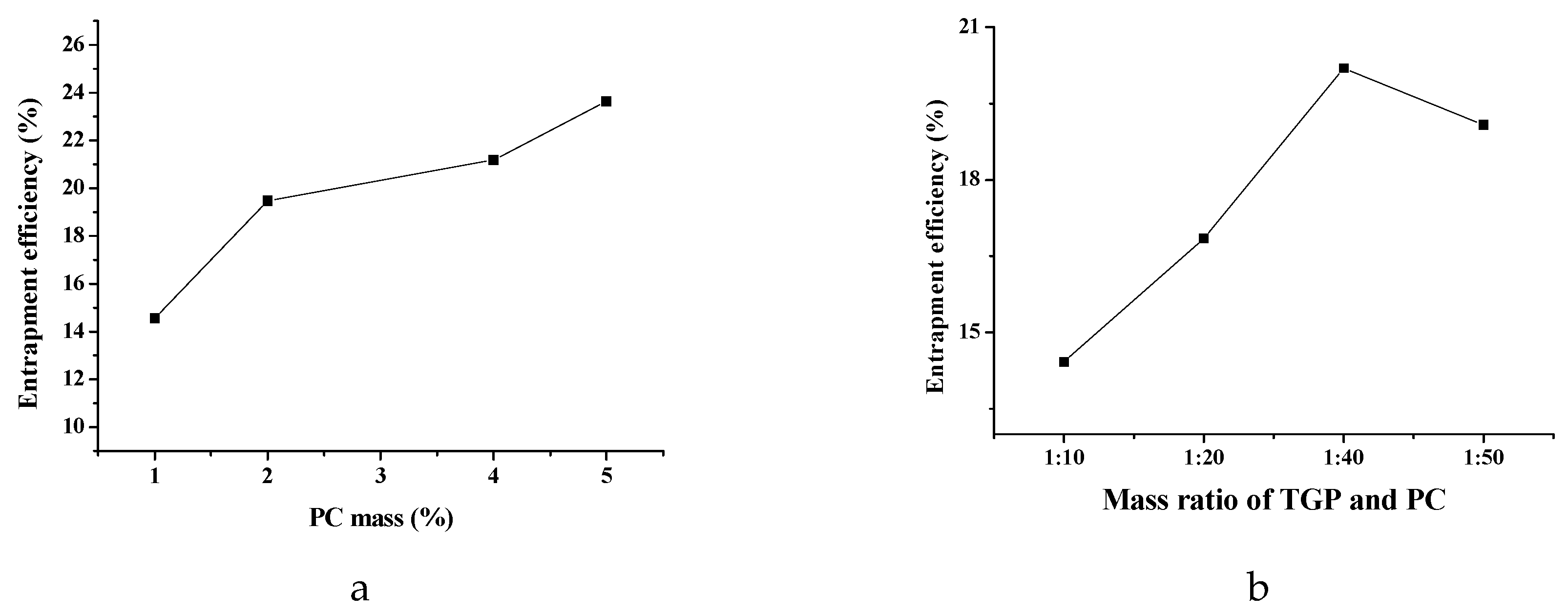

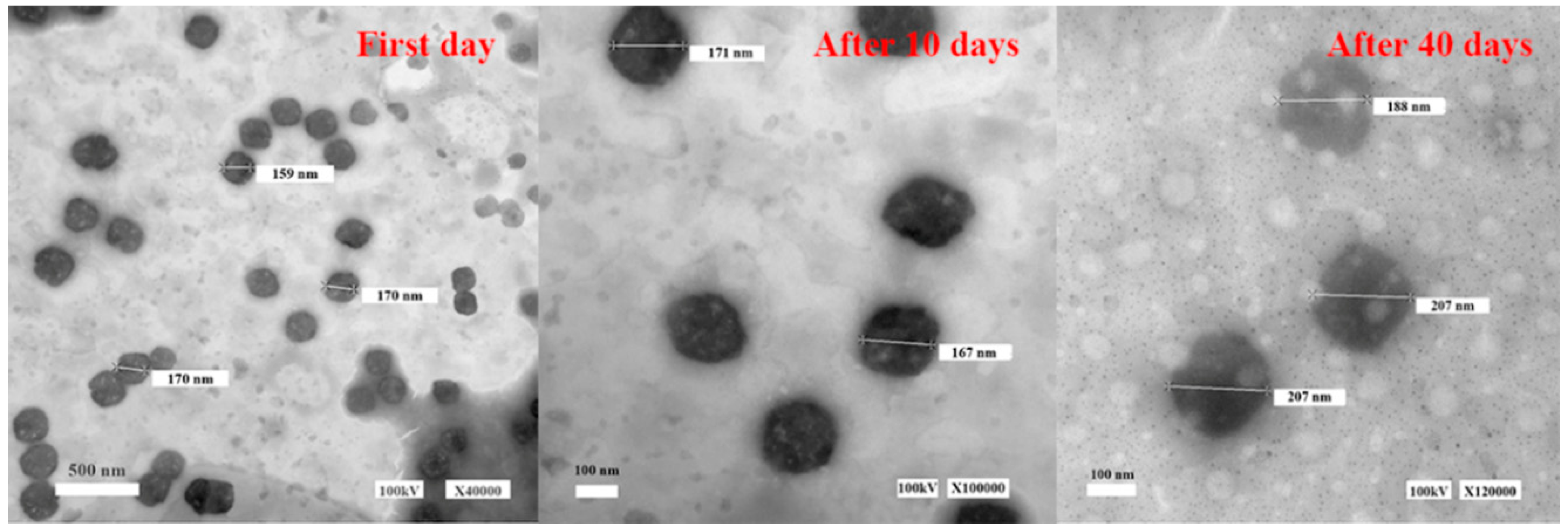
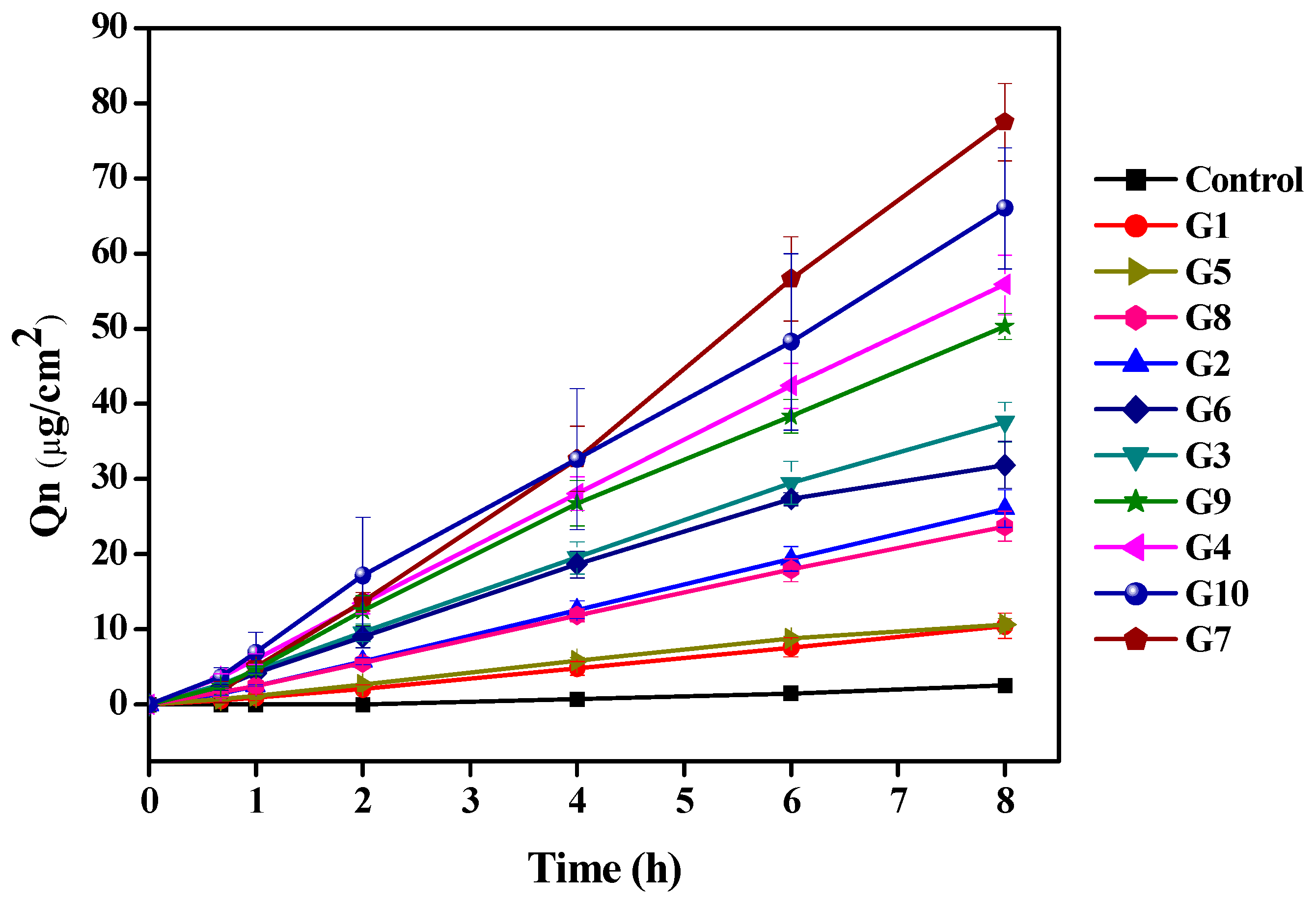
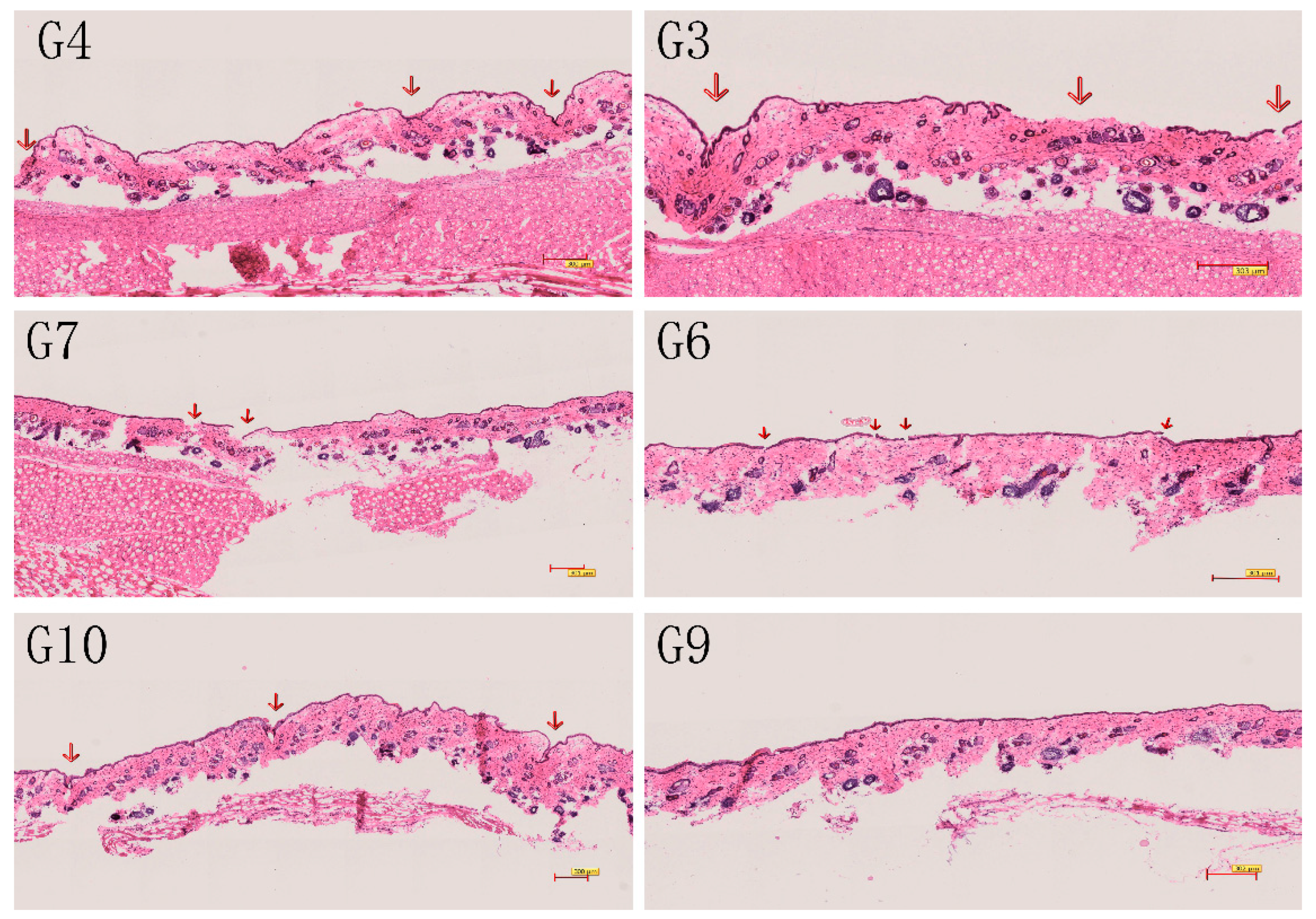
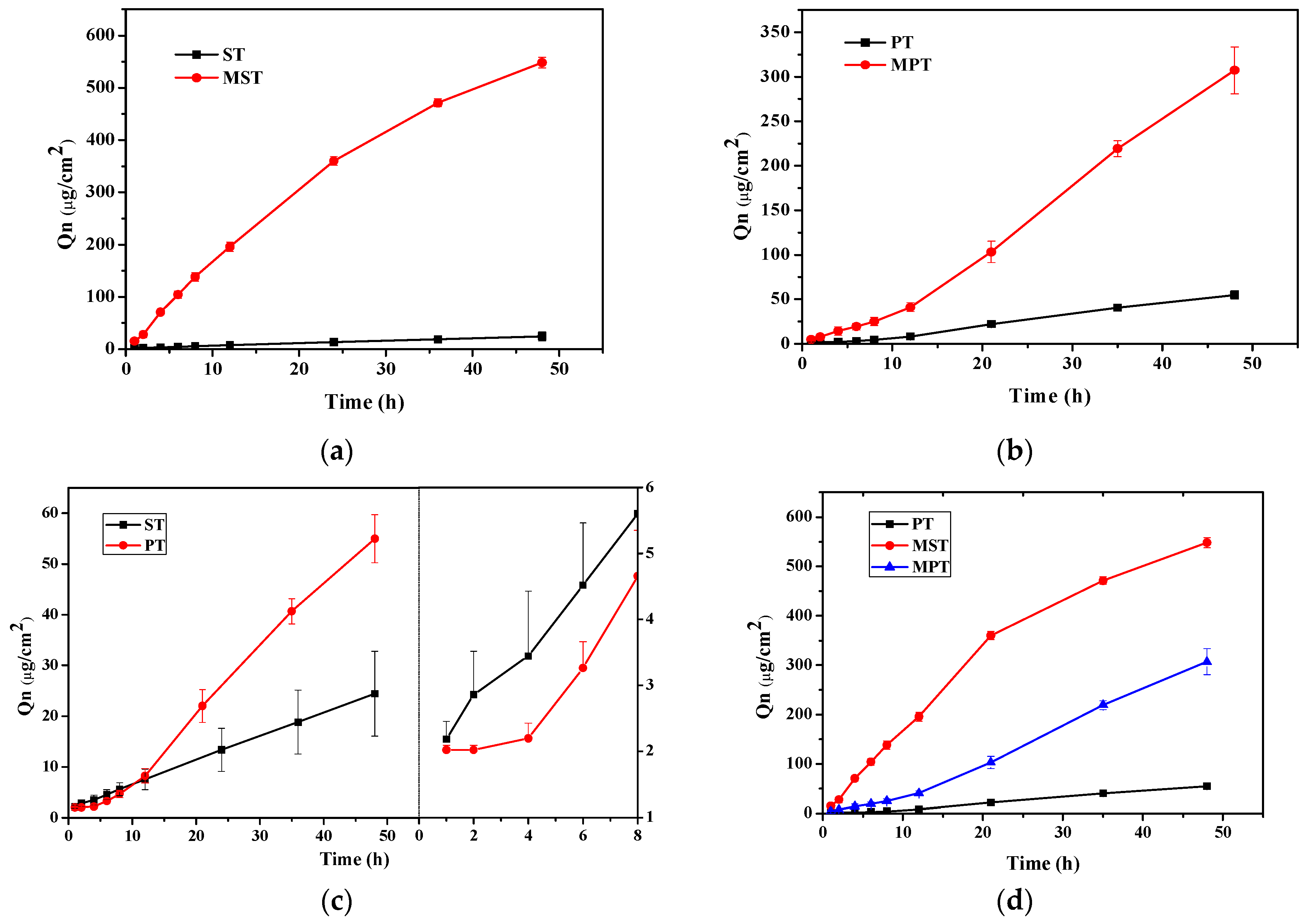

| Variables | Levels | ||
|---|---|---|---|
| 1 | 2 | 3 | |
| A/% | 2 | 4 | 5 |
| B | 1:10 | 1:20 | 1:40 |
| C | 5 | 6.5 | 7.3 |
| No. | Variables | Response | |||||
|---|---|---|---|---|---|---|---|
| A (mmol) | B (mg) | C | Errors | EE (%) | DL (%) | ||
| 1 | 1 (0.26) | 1 (20) | 1 (5) | 1 | 8.44 | 0.17 | |
| 2 | 1 (0.26) | 2 (10) | 2 (6.5) | 2 | 8.25 | 0.08 | |
| 3 | 1 (0.26) | 3 (5) | 3 (7.3) | 3 | 15.18 | 0.08 | |
| 4 | 2 (0.52) | 1 (40) | 2 (6.5) | 3 | 12.08 | 0.49 | |
| 5 | 2 (0.52) | 2 (20) | 3 (7.3) | 1 | 19.58 | 0.40 | |
| 6 | 2 (0.52) | 3 (10) | 1 (5) | 2 | 15.95 | 0.16 | |
| 7 | 3 (0.65) | 1 (50) | 3 (7.3) | 2 | 27.85 | 1.39 | |
| 8 | 3 (0.65) | 2 (25) | 1 (5) | 3 | 21.49 | 0.54 | |
| 9 | 3 (0.65) | 3 (12.5) | 2 (6.5) | 1 | 18.06 | 0.23 | |
| EE (%) | K1 | 31.86 | 48.36 | 45.87 | 46.08 | ||
| K2 | 47.61 | 49.31 | 38.39 | 52.04 | |||
| K3 | 67.39 | 49.19 | 62.60 | 48.74 | |||
| REE | 35.53 | 0.95 | 24.22 | 5.96 | |||
| DL (%) | K1 | 0.33 | 2.05 | 0.86 | 0.79 | ||
| K2 | 1.04 | 1.02 | 0.80 | 1.63 | |||
| K3 | 2.16 | 0.46 | 1.87 | 1.10 | |||
| RDL | 1.83 | 1.59 | 1.07 | 0.31 | |||
| Response | Sources of Variation | Sum of Squares | df | Mean Square | F Value | P Value | Significance |
|---|---|---|---|---|---|---|---|
| EE | A | 13.17 | 2 | 6.59 | 28.04 | 0.0001 | *** |
| B | 19.16 | 2 | 9.58 | 40.78 | <0.0001 | *** | |
| C | 496.29 | 2 | 248.14 | 1056.26 | <0.0001 | *** | |
| Error | 6.08 | 2 | 3.04 | ||||
| DL | A | 1.13 | 2 | 0.56 | 50994.0 | <0.0001 | *** |
| B | 0.86 | 2 | 0.43 | 38908.5 | <0.0001 | *** | |
| C | 0.48 | 2 | 0.24 | 21799.5 | <0.0001 | *** | |
| Error | 0.24 | 2 | 0.12 |
| Batches | EE (%) | DL (mg/mL) | ||||
|---|---|---|---|---|---|---|
| 1 | 2 | 3 | 1 | 2 | 3 | |
| A3B1C3 | 29.27 | 25.99 | 28.2 | 1.46 | 1.30 | 1.41 |
| A3B2C3 | 31.17 | 28.54 | 31.88 | 0.78 | 0.72 | 0.81 |
| A3B3C3 | 33.98 | 30.09 | 27.79 | 0.43 | 0.38 | 0.35 |
| P-value | >0.05 | <0.05 | ||||
| Mean score | 1 > 2 > 3 | |||||
| Optimal conditions | A3B1C3 | |||||
| Day | EE (%) | PS (nm) | ZP (mV) | PDI |
|---|---|---|---|---|
| 0 | 27.82 ± 1.56 | 137.9 ± 7.57 | −0.74 ± 0.43 | 0.120 ± 0.005 |
| 10 | 26.07 ± 1.07 | 145.3 ± 2.69 | −0.64 ± 0.42 | 0.122 ± 0.002 |
| 40 | 23.29 ± 1.39 | 206.8 ± 13.36 | −0.91 ± 1.58 | 0.254 ± 0.010 |
| Group | Steady-state Absorption Curve Regression Equation | r | Qn (μg/cm2) | Kp × 10−3 cm−2·h−1 | ER | |
|---|---|---|---|---|---|---|
| Control | Qn = 0.4551t − 1.119 | 0.9973 | 2.57 | 0.91 ± 0.18 | ||
| G1 | 250 μm-2 min-3 N | Qn = 1.3581t − 0.5055 | 0.9997 | 10.45 | 3.31 ± 0.48 | 3.64 |
| G2 | 500 μm-2 min-3 N | Qn = 3.3636t − 0.8619 | 0.9999 | 26.02 | 7.80 ± 0.73 | 8.57 |
| G3 | 750 μm-2 min-3 N | Qn = 4.8148t − 0.1784 | 0.9992 | 37.56 | 10.02 ± 0.76 | 11.01 |
| G4 | 1000 μm-2 min-3 N | Qn = 7.1644t − 0.9841 | 0.9998 | 55.84 | 16.26 ± 1.06 | 17.87 |
| G5 | 500 μm-2 min-1 N | Qn = 1.4009t − 0.1004 | 0.9969 | 10.67 | 3.52 ± 0.18 | 3.87 |
| G6 | 500 μm-2 min-5 N | Qn = 4.1738t + 0.4792 | 0.9931 | 31.89 | 10.01 ± 0.99 | 11.00 |
| G7 | 500 μm-2 min-7 N | Qn = 10.374t − 6.2684 | 0.9989 | 77.49 | 21.70 ± 1.64 | 23.85 |
| G8 | 500 μm-1 min-3 N | Qn = 3.037t − 0.4476 | 0.9997 | 23.71 | 7.16 ± 0.57 | 7.87 |
| G9 | 500 μm-3 min-3 N | Qn = 6.5585t − 1.1798 | 0.9998 | 50.29 | 13.69 ± 0.53 | 15.04 |
| G10 | 500 μm-5 min-3 N | Qn = 8.3641t − 1.0877 | 0.9993 | 66.03 | 17.17 ± 2.72 | 18.87 |
© 2018 by the authors. Licensee MDPI, Basel, Switzerland. This article is an open access article distributed under the terms and conditions of the Creative Commons Attribution (CC BY) license (http://creativecommons.org/licenses/by/4.0/).
Share and Cite
Cui, Y.; Mo, Y.; Zhang, Q.; Tian, W.; Xue, Y.; Bai, J.; Du, S. Microneedle-Assisted Percutaneous Delivery of Paeoniflorin-Loaded Ethosomes. Molecules 2018, 23, 3371. https://doi.org/10.3390/molecules23123371
Cui Y, Mo Y, Zhang Q, Tian W, Xue Y, Bai J, Du S. Microneedle-Assisted Percutaneous Delivery of Paeoniflorin-Loaded Ethosomes. Molecules. 2018; 23(12):3371. https://doi.org/10.3390/molecules23123371
Chicago/Turabian StyleCui, Yahua, Yujia Mo, Qi Zhang, Wanwan Tian, Yutao Xue, Jie Bai, and Shouying Du. 2018. "Microneedle-Assisted Percutaneous Delivery of Paeoniflorin-Loaded Ethosomes" Molecules 23, no. 12: 3371. https://doi.org/10.3390/molecules23123371
APA StyleCui, Y., Mo, Y., Zhang, Q., Tian, W., Xue, Y., Bai, J., & Du, S. (2018). Microneedle-Assisted Percutaneous Delivery of Paeoniflorin-Loaded Ethosomes. Molecules, 23(12), 3371. https://doi.org/10.3390/molecules23123371





